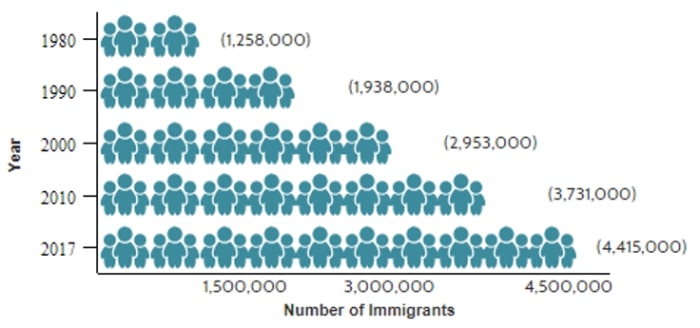Summary | Excerpt | Reading Guide | Reviews | Beyond the Book | Read-Alikes | Genres & Themes | Author Bio

This article relates to Saint X
 In Saint X by Alexis Schaitkin, one of the main characters is a Caribbean immigrant working as a taxi driver in New York City. While the island depicted in the novel is fictional, people hailing from the Caribbean make up a large portion of the immigrant population in the U.S.
In Saint X by Alexis Schaitkin, one of the main characters is a Caribbean immigrant working as a taxi driver in New York City. While the island depicted in the novel is fictional, people hailing from the Caribbean make up a large portion of the immigrant population in the U.S.
The individual islands in the Caribbean are all distinct in terms of culture, climate, history and dialect, but many of these nations share patterns when it comes to immigration. According to a Pew Research study from 2017, Caribbean people make up 10% of America's immigrant population. Looking at Caribbean immigrants as a group, the largest populations come from Cuba (29%), then the Dominican Republic (26%), Jamaica (16%), and Haiti (15%), according to the Migration Policy Institute (MPI). The U.S. Census groups Latin American and Caribbean countries together, and puts the total number of immigrants from this region collectively at 21.2 million in 2010.
Since the abolition of slavery in the regions colonized by Britain and France in 1834 and 1848 respectively, the Caribbean has seen more voluntary migration than any other region in the world—according to a 2017 survey by the IMF, 22% of the ethnically Caribbean population lives abroad. Migration from the Caribbean to the U.S. increased in the mid-20th century, when many immigrants were enticed by the booming post-World War II economy. Following the passage of the Immigration Act of 1965 in the U.S., the naturalization process became easier for those from countries outside Europe, and the 1960s saw a dramatic increase in skilled professionals relocating from Caribbean nations. Many of their families either came with them or followed a short time later. Between 1980 and 2000, the Caribbean immigrant population in the U.S. increased by over 50% every 10 years, according to the MPI (see graph).
Reasons for immigration are naturally complex and varied. In some cases, those who are highly skilled in a field may leave their home country or region for better opportunities in the U.S. or abroad. The mass exodus of young and skilled workers is a phenomenon known as "brain drain," or "human capital flight." This practice results in economic loss for the home country, a loss that carries on through the years as there are fewer educated and skilled people on hand to teach and train the next generation. Some countries, like Jamaica, have implemented governmental initiatives to bring skilled workers back home from abroad. Caribbean countries (with the exception of Cuba and Haiti) have also seen an increase in retirees returning to their nations of origin.
Some people migrate because of issues that are entirely out of their control, such as natural disasters and organized crime (the murder rate in the Caribbean is one of the highest in the world). The U.S. is a popular destination, since most islands in the Caribbean have been U.S. territories or under U.S. control at some point, leading to government initiatives that encourage migration. One such initiative is the Diversity Visa lottery program, which began in 1990 and offers 55,000 visas annually to citizens from countries with low immigration rates to the U.S. in order to diversify the population. There have also been nation-specific legislative acts in the U.S. providing immigration opportunities for Cubans and Haitians in particular—the Cuban Adjustment Act of 1966, and the Temporary Protected Status (TPS) designation offered after the earthquake in Haiti in 2010. (Homeland Security ended this TPS program in 2019.)
Once in the U.S., Caribbean immigrants may obtain a green card through family sponsorship programs, or by seeking asylum, and are more likely to be naturalized as U.S. citizens than immigrants from most other regions (59% of Caribbean immigrants are naturalized citizens, according to the MPI—the national average is 49%). The majority of Caribbean immigrants in the U.S. live in Florida, followed by New York, with New York City being the top metropolitan area for individuals with Caribbean origins.
Caribbean immigration increase graph, courtesy of Migration Policy Institute
Filed under People, Eras & Events
![]() This "beyond the book article" relates to Saint X. It originally ran in March 2020 and has been updated for the
May 2021 paperback edition.
Go to magazine.
This "beyond the book article" relates to Saint X. It originally ran in March 2020 and has been updated for the
May 2021 paperback edition.
Go to magazine.






Your guide toexceptional books
BookBrowse seeks out and recommends the best in contemporary fiction and nonfiction—books that not only engage and entertain but also deepen our understanding of ourselves and the world around us.